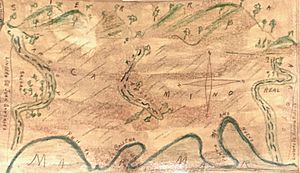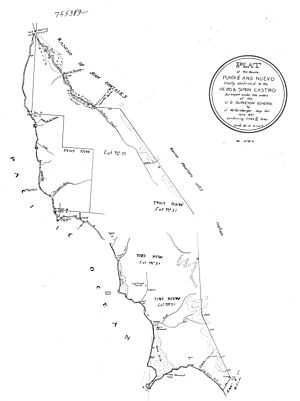Rancho Punta del Año Nuevo facts for kids
Rancho Punta del Año Nuevo was a very large piece of land, about 17,753 acres, given out by the Mexican government. It was a "land grant" in what is now San Mateo County, California. In 1842, Governor Juan B. Alvarado gave this land to Simeon Castro. Back then, this land was part of Santa Cruz County, California. Later, in 1868, the county borders changed, and it became part of San Mateo County. The land stretched along the Pacific coast. It went from Rancho Butano in the north, past Pigeon Point, all the way to Point Año Nuevo in the south.
Contents
Exploring the Rancho's Past
Early Explorers and Native Villages
The first European explorers to travel through Alta California were part of the Spanish Portolá expedition. They passed through this area in 1769. They recognized Point Año Nuevo, which had been named by Spanish explorer Sebastián Vizcaíno in 1603. On October 23, 1769, the expedition camped near a creek north of the point. There, they found a large native village.
A missionary named Juan Crespí was with the expedition. He wrote in his diary about a huge, round house in the middle of the village. It was big enough for everyone in the town. Around it were smaller, pyramid-shaped houses made of pine stakes. The soldiers called it the "Village of the Casa Grande" because of the large house.
Mission Lands and New Beginnings
Around 1816, Mission Santa Cruz started a cattle ranch in this area. They called it "el Rancho del Punta de Año Nuevo." They built a small adobe building. Mission Indians lived there and took care of many cattle, sometimes as many as 3,600. Over time, Mission Santa Cruz expanded its grazing lands even further north.
When Mexico gained control of California, big changes happened. The mission lands were broken up. More settlers moved into California. People asked for land grants, and between 1834 and 1836, the Mexican government gave away millions of acres of mission land. Without the missions, the Native Americans lost their claims to the land. The former mission cattle ranches were divided into three new Mexican land grants. These included Rancho San Antonio- or Pescadero, Rancho Punta del Año Nuevo, and Rancho Butano.
Simeon Castro and His Family
José Simeon Nepomuncena Castro (1783–1842) was an important person in the area. He was born in Santa Barbara, California. Simeon Castro was a soldier in Monterey, California in 1809. He also served as a leader, or alcalde, in Monterey. He married Maria Antonia Pico. Simeon Castro received two land grants: Rancho Bolsa Nueva y Moro Cojo in 1837, and Rancho Punta del Año Nuevo in 1842. He passed away in 1842.
Changes Under United States Rule
After the Mexican–American War, California became part of the United States. The 1848 Treaty of Guadalupe Hidalgo said that the existing land grants would be respected. In 1852, a claim for Rancho Punta del Año Nuevo was filed with the government. The land grant was officially given to Maria Antonia Pico de Castro and Simeon Castro's heirs in 1857.
In 1851, Maria Antonia Pico de Castro sold Rancho Punta del Año Nuevo to Isaac Graham. He was a pioneer in Santa Cruz County. Graham, or someone renting from him, built a two-story white house in 1857. This house is remembered in the name of Whitehouse Creek today.
New Owners and Land Use
In 1862, two men named Clark and Coburn from San Francisco bought both Rancho Butano and Rancho Punta del Año Nuevo. Loren Coburn came to California in 1851 and first worked in mining. He later bought out his business partner, Jeremiah Clark. Coburn was very protective of his land. He often went to court to defend his property lines.
Coburn rented out much of the land to the Steele family. The Steele family ran a large dairy farm there. In 1869, the Steele family bought 7,000 acres south of Gazos Creek. Coburn and Clark's efforts to protect their land meant that Rancho Punta del Año Nuevo was not divided and developed quickly.
Historic Sites of the Rancho



